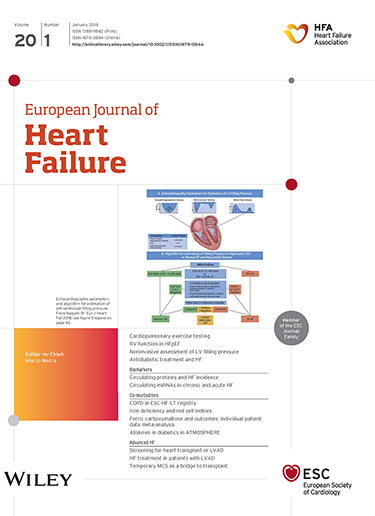Renal denervation improves cardiac function and exercise duration in a miniswine model of heart failure with preserved ejection fraction.
IF 16.9
1区 医学
Q1 CARDIAC & CARDIOVASCULAR SYSTEMS
引用次数: 0
Abstract
AIMS Overactivity of the sympathetic nervous system is a common underlying mechanism in development and progression of several heart failure with preserved ejection fraction (HFpEF) comorbidities. Decreasing renal sympathetic nerve activity using catheter-based renal denervation (RDN) systems have shown efficacy in treating resistant hypertension and cardiac dysfunction in heart failure with reduced ejection fraction. The purpose of this study was to determine if modulation of renal sympathetic nerve activity by RDN improves cardiac function and exercise tolerance in a clinically-relevant minipig model of cardiometabolic HFpEF. METHODS AND RESULTS Multiple HFpEF comorbidities were induced in adult female Göttingen minipigs by mineralocorticoid excess and a diet high in cholesterol, fat, fructose, and salt. HFpEF minipigs were randomized to bilateral catheter-RDN (n = 5) treatment or sham-RDN (n = 4). RDN therapy reduced renal sympathetic activity in HFpEF minipigs and increased treadmill exercise duration. Following RDN treatment, sustained improvements in diastolic function including E/e' and left atrial fractional area change were observed. Elevations in resting left ventricular filling and pulmonary pressures in HFpEF minipigs, while indicative of HFpEF severity, were unaffected by RDN treatment. Following RDN treatment, there was a transient reduction in arterial blood pressure and no change in heart rate. CONCLUSIONS Device-based RDN may be a potential therapeutic strategy to halt the progression of HFpEF by improving cardiac diastolic function and exercise tolerance.在一个保留射血分数的心力衰竭迷你模型中,肾去神经支配改善心功能和运动时间。
交感神经系统的抑制活性是几种具有保留射血分数(HFpEF)合并症的心力衰竭发生和进展的共同潜在机制。利用导管肾去神经支配(RDN)系统降低肾交感神经活动对治疗顽固性高血压和心力衰竭伴射血分数降低的心功能障碍有效。本研究的目的是在临床相关的心脏代谢性HFpEF迷你猪模型中,确定RDN对肾交感神经活动的调节是否能改善心功能和运动耐量。方法与结果:矿化皮质激素过量和高胆固醇、高脂肪、高果糖和高盐饮食诱导成年雌性Göttingen迷你猪出现多种HFpEF合并症。HFpEF迷你猪随机分为双侧导管- rdn治疗组(n = 5)和假rdn治疗组(n = 4)。RDN治疗降低了HFpEF迷你猪的肾交感神经活动,并增加了跑步机运动时间。RDN治疗后,舒张功能持续改善,包括E/ E′和左房分数面积变化。HFpEF小型猪静息左室充血和肺动脉压升高,虽然表明HFpEF严重程度,但不受RDN治疗的影响。RDN治疗后,动脉血压有短暂性降低,心率无变化。结论基于器械的RDN可能是通过改善心脏舒张功能和运动耐量来阻止HFpEF进展的潜在治疗策略。
本文章由计算机程序翻译,如有差异,请以英文原文为准。
求助全文
约1分钟内获得全文
求助全文
来源期刊

European Journal of Heart Failure
医学-心血管系统
CiteScore
27.30
自引率
11.50%
发文量
365
审稿时长
1 months
期刊介绍:
European Journal of Heart Failure is an international journal dedicated to advancing knowledge in the field of heart failure management. The journal publishes reviews and editorials aimed at improving understanding, prevention, investigation, and treatment of heart failure. It covers various disciplines such as molecular and cellular biology, pathology, physiology, electrophysiology, pharmacology, clinical sciences, social sciences, and population sciences. The journal welcomes submissions of manuscripts on basic, clinical, and population sciences, as well as original contributions on nursing, care of the elderly, primary care, health economics, and other related specialist fields. It is published monthly and has a readership that includes cardiologists, emergency room physicians, intensivists, internists, general physicians, cardiac nurses, diabetologists, epidemiologists, basic scientists focusing on cardiovascular research, and those working in rehabilitation. The journal is abstracted and indexed in various databases such as Academic Search, Embase, MEDLINE/PubMed, and Science Citation Index.
 求助内容:
求助内容: 应助结果提醒方式:
应助结果提醒方式:


